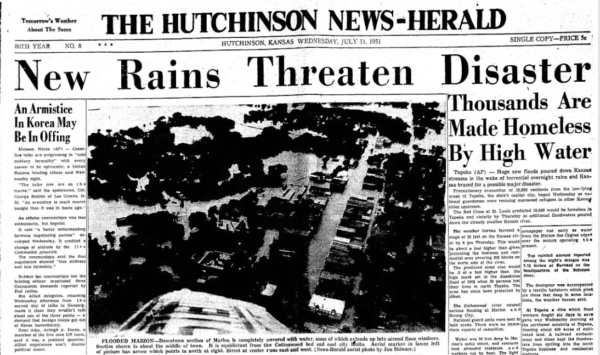The Epic 1951 Flood in Kansas

By Bill Murray
The Alabama Weather Blog
When you think about Kansas and natural disasters, you naturally think about tornadoes, or droughts, or maybe blizzards. But did you know that the state’s worst natural disaster came from an epic 1951 flood?
On the morning of Wednesday, July 11th, normally placid Kansas rivers were raging out of control after a night of all-night rains. 7.75 inches of rain fell during the night at Barnard. Conditions had been wet through much of May and June across the Great Plains. But heavy storms between the 9th and 13th dumped as much as 17 inches in spots across the Sunflower State.
The Kansas and Blue Rivers intersect near the town of Manhattan, Kansas. As the incredible rains bloated the rivers, they jumped their banks and flooded the town. City Police and Firemen were forced from the flooded Municipal Building.
It was impossible for forecasters to predict just how high the rivers would crest at Manhattan because of the continuing heavy rains, but they warned that it was a very serious situation.
In Topeka, residents were preparing for an expected near-record crest of 30.5 feet on the Kansas River. Hundreds of volunteers were sandbagging dikes in the city. Evacuations were already beginning in low-lying areas of the city, which had been inundated by a disastrous flood in 1903. There were predictions that 19,000 people would be made homeless in the Kansas capital.
Along the Cottonwood River, the towns of Marion and Strong were under water. Water was ten feet in Marion’s main street. Twenty people were plucked from rooftops at Strong.
Transportation was at a standstill across the region. Rail lines were blocked at many points. Highways were underwater all across northern Kansas. Passenger trains were stopped at Newton and Emporia.
The epic 1951 floods in Kansas resulted in the creation of the Tuttle Creek Dam and reservoir. The building of this and other reservoirs has not stopped flooding, but at least lives have not been lost.
The Global Weather and Climate Center has a content-sharing agreement with the Alabama Weather Blog. Selected articles are shared between the two sites. Bill Murray holds the National Weather Association Digital Seal of Approval.
Category: ALL POSTS, Met 101/Weather History


















